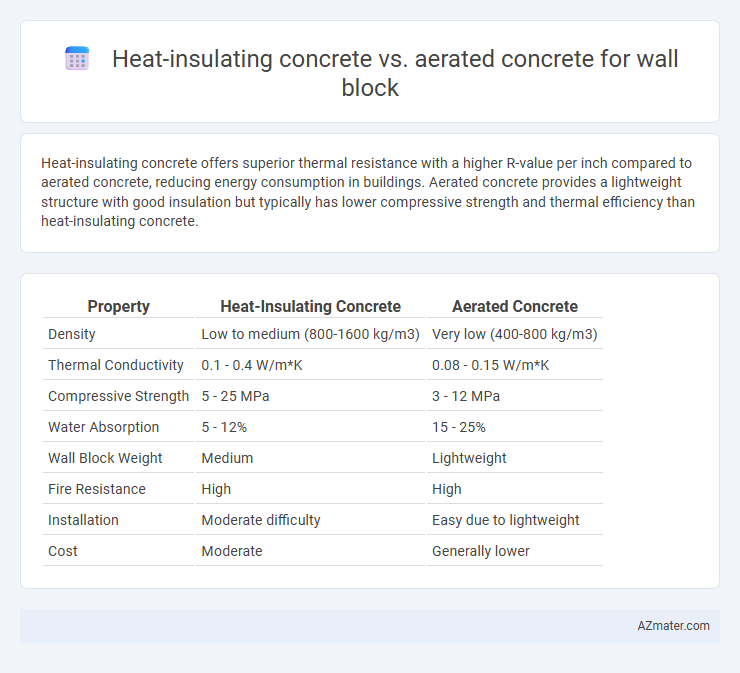Heat-insulating concrete offers superior thermal resistance with a higher R-value per inch compared to aerated concrete, reducing energy consumption in buildings. Aerated concrete provides a lightweight structure with good insulation but typically has lower compressive strength and thermal efficiency than heat-insulating concrete.
Table of Comparison
| Property | Heat-Insulating Concrete | Aerated Concrete |
|---|---|---|
| Density | Low to medium (800-1600 kg/m3) | Very low (400-800 kg/m3) |
| Thermal Conductivity | 0.1 - 0.4 W/m*K | 0.08 - 0.15 W/m*K |
| Compressive Strength | 5 - 25 MPa | 3 - 12 MPa |
| Water Absorption | 5 - 12% | 15 - 25% |
| Wall Block Weight | Medium | Lightweight |
| Fire Resistance | High | High |
| Installation | Moderate difficulty | Easy due to lightweight |
| Cost | Moderate | Generally lower |
Introduction to Heat-Insulating Concrete and Aerated Concrete
Heat-insulating concrete is a dense material enhanced with insulating additives such as expanded polystyrene beads or perlite, designed to reduce thermal conductivity and improve energy efficiency in wall blocks. Aerated concrete, also known as autoclaved aerated concrete (AAC), features a lightweight, porous structure created by introducing air bubbles through chemical foaming agents, resulting in superior thermal insulation and fire resistance. Both materials offer significant advantages in wall block applications, balancing thermal performance, structural integrity, and ease of installation based on project requirements.
Composition and Material Differences
Heat-insulating concrete typically contains lightweight aggregates such as expanded clay, perlite, or vermiculite combined with cement and sand, optimizing thermal resistance through lower density and reduced thermal conductivity. Aerated concrete, also known as autoclaved aerated concrete (AAC), is produced using fine aggregates, cement, lime, water, and an expansion agent like aluminum powder, creating a porous structure with high air content for superior insulation and fire resistance. The key material difference lies in aerated concrete's chemically induced air pockets versus heat-insulating concrete's mechanically lightweight aggregates, impacting strength, insulation properties, and weight.
Thermal Insulation Properties Comparison
Heat-insulating concrete offers enhanced thermal insulation due to its dense composition combined with insulating additives, achieving thermal conductivity values typically around 0.12-0.18 W/m*K. Aerated concrete, characterized by its porous structure with air bubbles, provides superior thermal insulation with conductivity often as low as 0.08-0.12 W/m*K, effectively reducing heat transfer through wall blocks. The choice between these materials depends on insulation requirements and structural considerations, with aerated concrete generally outperforming heat-insulating concrete in minimizing energy loss.
Structural Strength and Load-Bearing Capacity
Heat-insulating concrete exhibits higher structural strength and load-bearing capacity compared to aerated concrete, making it suitable for walls requiring enhanced durability and support. Aerated concrete, characterized by its lightweight and porous structure, offers improved thermal insulation but lower compressive strength, limiting its use to non-load-bearing applications or secondary wall elements. Selecting between these materials depends on balancing the need for insulation with the structural demands of the building.
Energy Efficiency and Sustainability
Heat-insulating concrete offers superior thermal resistance due to embedded insulating materials, significantly reducing energy consumption for heating and cooling in buildings. Aerated concrete, characterized by its lightweight and porous structure, provides excellent thermal insulation while using fewer raw materials, enhancing sustainability by lowering carbon footprint during production. Both materials contribute to energy-efficient construction, but aerated concrete's eco-friendly manufacturing process and recyclability make it particularly advantageous for sustainable building projects.
Construction Process and Workability
Heat-insulating concrete offers superior thermal resistance and typically requires standard mixing and curing processes, making it compatible with conventional construction workflows. Aerated concrete, characterized by its lightweight and porous structure, demands specialized mixing techniques involving foaming agents and precise control over curing to achieve optimal strength and insulation properties. Workability in aerated concrete is generally higher due to its reduced density, facilitating easier cutting and installation compared to heavier heat-insulating concrete blocks.
Cost Analysis and Affordability
Heat-insulating concrete offers moderate cost efficiency with a denser composition that tends to increase material expenses but improves thermal regulation, reducing long-term energy costs. Aerated concrete, characterized by its lightweight, low-density structure, often presents a more affordable initial investment and faster installation, making it cost-effective for budget-conscious projects. Comparing both materials, aerated concrete typically delivers better affordability upfront, while heat-insulating concrete may offer enhanced economic benefits over time through energy savings.
Fire Resistance and Safety Features
Heat-insulating concrete offers superior fire resistance with a higher melting point and greater thermal stability, ensuring enhanced safety during high-temperature exposure in wall block applications. Aerated concrete provides inherent fireproof properties due to its porous structure, which slows heat transfer and prevents flame penetration, making it ideal for fire-resistant construction. Both materials contribute to improved fire safety, but heat-insulating concrete generally delivers better performance in extreme fire scenarios.
Durability and Longevity
Heat-insulating concrete offers superior durability due to its dense composition and resistance to moisture ingress, ensuring a longer lifespan in harsh environmental conditions. Aerated concrete provides excellent thermal insulation and lightweight properties but tends to have lower compressive strength and may be more susceptible to surface erosion over time. For wall blocks, heat-insulating concrete typically delivers enhanced longevity, particularly in applications requiring high structural integrity and resistance to weathering.
Best Applications for Each Concrete Type
Heat-insulating concrete excels in applications requiring enhanced thermal resistance, such as exterior walls in cold climates and energy-efficient buildings, due to its dense composition and superior insulating properties. Aerated concrete is best suited for interior partition walls, soundproofing, and lightweight construction projects where ease of handling, fire resistance, and thermal insulation are crucial. Both materials offer moisture resistance, but heat-insulating concrete provides higher compressive strength ideal for load-bearing structures, while aerated concrete's porous nature supports flexibility in design and faster installation.

Infographic: Heat-insulating concrete vs Aerated concrete for Wall block
 azmater.com
azmater.com